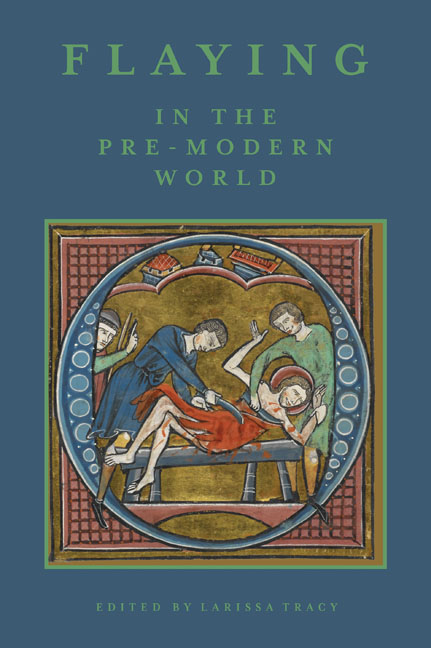6 - Robed in Martyrdom: The Flaying of St Bartholomew in the Laudario of Sant’Agnese
Published online by Cambridge University Press: 21 May 2021
Summary
ST BARTHOLOMEW is the most prominent flayed Christian martyr, perhaps best known in Michelangelo's rendition on the Last Judgement wall of the Sistine Chapel (1534–41). In this High Renaissance work, the saint holds the instrument of his martyrdom – a knife – in his right hand and his flayed skin, draped like an old coat, in his left. The figure holding his skin is, inexplicably, also wearing his skin. That is, he demonstrates his grisly martyrdom and simultaneously defies both its gore and its finality. Such a presentation of Bartholomew is common, particularly in iconic, rather than narrative, images, where the clothed saint holds his attribute and yet his skin remains intact. Two hundred years before this, the Florentine artist Pacino di Bonaguida (active c. 1303–c. 1347) created a complex composition to present this unsettling figure and his martyrdom. His strikingly different Bartholomew appears on a folio of the fragmentary Laudario of Sant’Agnese, a book of Italian hymns produced for the Compagnia di Sant’Agnese (Confraternity of St Agnes) (c. 1340, Fig. 6.1). The manuscript was disbound in the nineteenth century and only thirty-one illuminated leaves and fragments now survive, some by Pacino and others by the Master of the Dominican Effigies.
The Bartholomew folio, housed in the collection of the Cloisters Museum, New York, presents five moments within (and bursting out of) three frames. Three scenes are contained within the central frame, divided into two conjoined rectangular panels that occupy the upper half of the text block. The opening of the lauda for Bartholomew is below: ‘Appostolo beato da gesu cristo amato. Bartholomeo te laudiam diboncore’ [Blessed Apostle, loved by Jesus Christ, Bartholomew we praise you whole-heartedly]. In the left margin, which was the outer margin when this folio was bound, there are two small roundels, connected by delicate, multicoloured leafy decoration that then spills downward and unfurls into the lower margin. The beauty and elegance of the foliate work, dominated by pinks and blues and highlighted with spots and points of gold, stand in sharp contrast with the horrific acts occurring in the images it frames.
- Type
- Chapter
- Information
- Flaying in the Pre-Modern WorldPractice and Representation, pp. 141 - 172Publisher: Boydell & BrewerPrint publication year: 2017
- 1
- Cited by



